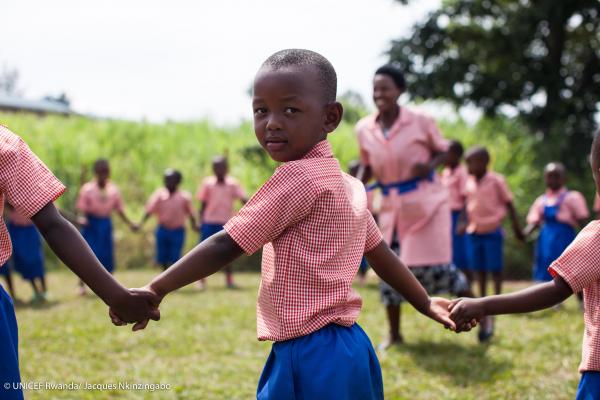
Social Protection. Credit Photo: UNICEF
Vulnerable children in Rwanda will soon be classified among categories of persons who will benefit from the country’s social protection program, officials have said.
Jean Claude Rwahama, the Ag. Director of the Social Protection Unit, at Rwanda Local Administrative Entities Development Agency (LODA) made the revelation during the 4th Policy Dialogue in Investing in Children and Young People in Rwanda this April 27, 2023.
The response comes after children who participated in the dialogue raised concerns on poverty as a root cause of many children lacking access to health, sanitation, dropping out of school and turning to street children.
In response, Rwahama said that the ministry of local government is currently planning to unveil an additional category under the VUP program which will cater for specific needs of children such as street children among others.
“This program has new activities in which these children will be identified and offered financial support including street children,” Rwahama said.
Rwahama stated that this financial support will enable the beneficiaries to afford education and deal with poverty related challenges.
The dialogue was aimed at discussing investment in children and young people and engage policy makers in planning and budgeting and development partners in a strategic reflection on how to implement the recommendations from Fiscal Space Analysis (FSA 2021) in a Performance Based Budget Framework
Figures from the FSA findings showed that despite the increase in budget allocation, the Social Protection (SP) and Water, Sanitation and Hygiene (WASH) budgets have been fluctuating in the past four years at a stagnated 25% on average and lacking in rural areas.
For instance, the deprivation level (by dimensions) in Housing, Development, Nutrition, Health and Sanitation for children between 24-59 months remained high with housing needs being the highest at 69.6%.
The allocations to priority sectors for children have expanded in nominal terms from Rwf700.1 billion in 2018/19 to Rwf1,189.3 billion in 2022/23, representing an increase of 70% over the past five years.
The Education sector budget has been the main government priority among social sectors (from Rwf479.1billion to Rwf 573.5 million) and the Health sector budget shows fluctuating trends from Rwf441.4 billion to Rwf 365.2 billion) while both health and WASH budgets have been cut during budget revisions.
Gaps towards NST1
The FSA findings also showed despite investment in social sector programs, the financing gap rose from Rwf830billion to Rwf2,460 billion between 2021/22 and 2029/30 and this could affect the government achieving National Strategy for Transformation (NST1) targets.
The report stated that to reach NST1 and SDG targets, the government needs to spend over Rwf100,000 RWF ($90) per person each year on social sectors.
To raise this money, the report recommended increasing tax revenues by raising tax by 0.3% per year and raising the allocation of social sectors by 0.5% per year. This would reduce the gap by 18% by 2030.
It recommended implementation of efficiency measures across all child-focused social sectors could reduce the financing gap by 10% of total government expenditures.
It also suggested external finance and innovative financing: debt relief and additional official development assistance (ODA) to reduce the child financing gap entirely, and use of innovative or blended financing; however, the level of potential funding has not been quantified.
The Economic Policy Research Network (EPRN) Rwanda Board Member, Agaba Broad, said the government is committed to engaging stakeholders in coming up with solutions but called for developing human capital as a tool of sustainability and improving wellbeing of Rwandans at an early age.

